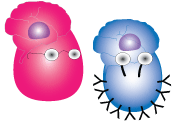
Lymphocyte development and generation of tolerance in primary lymphoid organs
B and T cells both originate in the bone marrow, which is a primary lymphoid organ. B cells complete their Ig gene recombination here while immature T cells travel to the other primary lymphoid organ, the thymus, where they rearrange their TCR genes. With the huge diversity of Igs and TCRs that we saw being made in these organs in the last page, it is not surprising to find that some have the ability to bind the host's own molecules. What would happen if cells capable of recognising the host are allowed out into the circulation? There could be a potential attack on our own cells. We need to tolerate ourselves! To help protect us from destroying our own cells and tissues, mechanisms of weeding out self-reactive cells have evolved. Most self-reactive B and T cells are killed during their development in the primary lymphoid organs. Take a look at this video of T cell development and try identifying how these self-reactive T cells are deleted. What is this process called?

The developing T cells, called thymocytes, that bound self-peptides:MHC complexes too strongly did not receive any more maturation and survival signals and were sent to their death; this is the process of negative selection which eliminates most of our self-reactive lymphocytes.
B cells are also going through a similar negative selection process in the bone marrow where they are denied survival signals and die if they bind self-antigens. However, some self-reactive B cells are given a second chance and are allowed to rearrange a different L chain variable region, and if the new Ig no longer binds self-antigen, the B cell's life is spared.
Did you notice that the thymocytes in the video also went through another selection step? The thymocytes were first tested for their ability to bind the host's MHC molecules in a process called positive selection. If they bound they lived! This is important as without this capability, our T cells would not be able to recognise anything that our APCs are presenting. B cells don't need to go through positive selection as they recognise antigens in their native form. The end result of these selection processes very cleverly result in the survival of T cells that recognised MHC together with foreign peptides, and B cells that recognise foreign antigens, which is just what we need to be able to fight pathogens!
You can explore positive and negative selection of thymocytes for yourself using this flash animation.
Hints: If you point to the blue bubble directly above the green arrows in the lower left-hand corner you will find more explanatory text appearing. To get a cohesive story it is advisable to start by exploring positive selection.